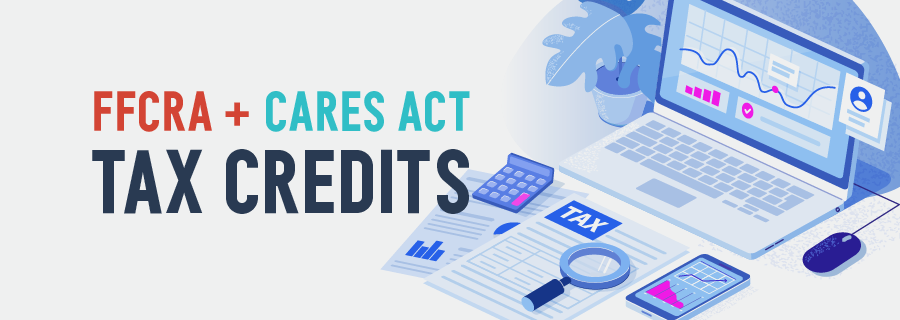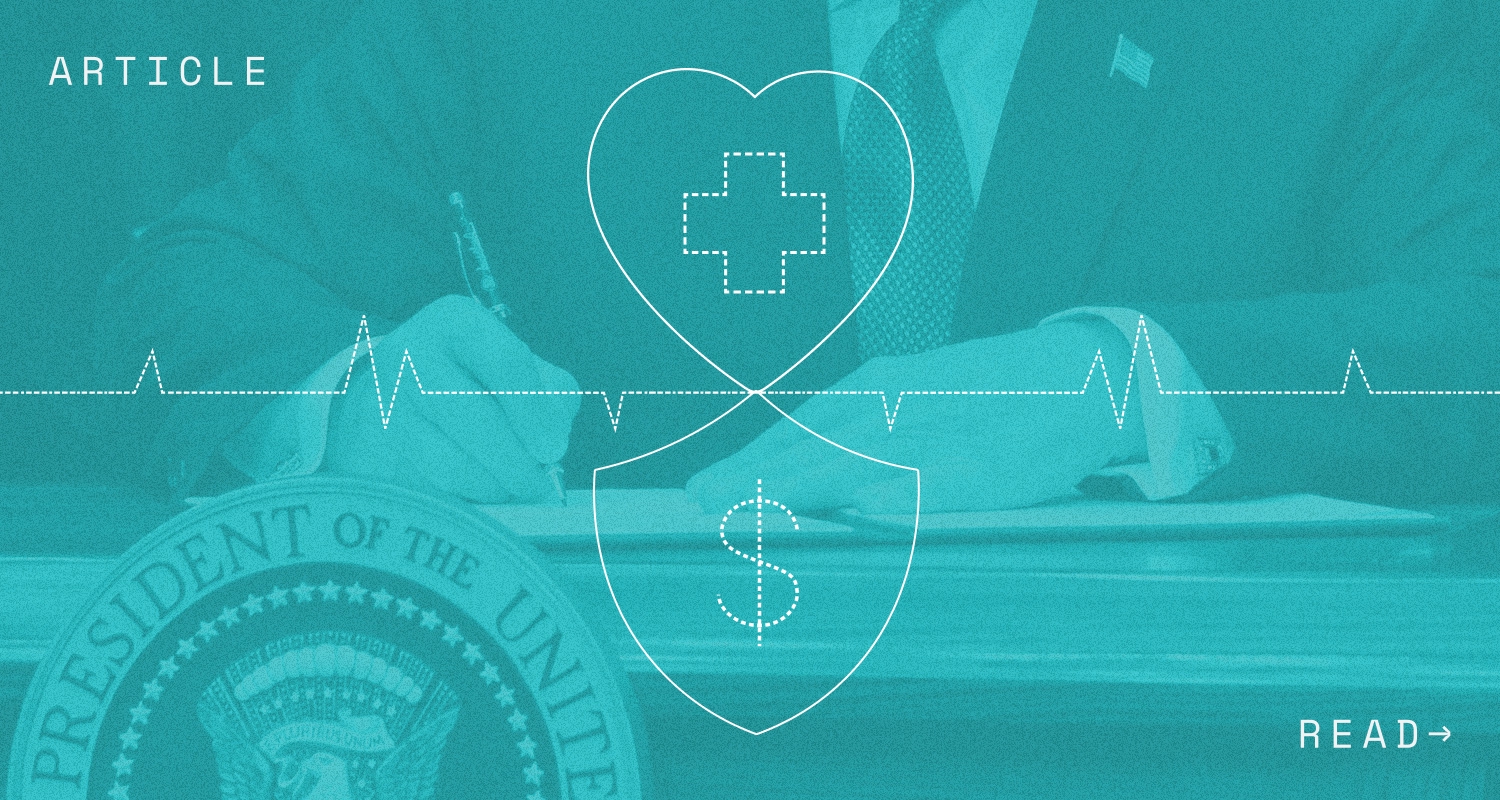Employers can receive tax credits for wages and healthcare provided to certain employees under the Families First Coronavirus Response Act (“FFCRA”) and the Coronavirus Aid, Relief and Economic Security Act (“CARES”) Employee Retention Credit. This article reviews the tax credits available for healthcare expenses and how to calculate these tax credits.
The Families First Coronavirus Response Act (FFCRA)
The FFCRA requires employees with less than 500 U.S. employees to provide emergency paid sick leave (EPSL) and emergency family leave (EFMLA) to eligible employees for coronavirus (COVID-19) related reasons. Although employers are required to continue providing healthcare to employees taking EPSL or EFMPLA, FFCRA provides employers with a 100% refundable tax credit for the qualified wages and qualified healthcare expenses provided to employees while they take FFCRA leave.
Below we discuss which expenses are considered “qualified healthcare expenses” eligible for FFCRA tax credits and how to calculate expenses related to employer-provided healthcare coverage.
FFCRA Qualified Health Expenses
Employers can receive tax credits for the following healthcare expenses provided to employees during FFCRA leave:
- The cost of maintaining a group health plan (the method for determining cost is discussed below); and
- Employer contributions toward employees’ Health Reimbursement Arrangements (HRAs) or healthcare Flexible Spending Accounts (FSAs) during the leave.
Employers cannot receive tax credits for employer contributions toward Health Savings Accounts (HSAs) or an Archer MSA. See Q&A #35 and #36 of the IRS guidance on FFCRA tax credits (“IRS FFCRA guidance”).
Important Note: Furloughed employees are not eligible to take FFCRA leave. Thus, employers cannot receive FFCRA tax credits for providing healthcare coverage to furloughed employees. However, employers may be able to receive tax credits for providing coverage to furloughed employees under the CARES Act Employee Retention Credit, as discussed below.
Calculating the Cost of Providing Group Health Plan (GHP) Coverage
The tax credit that employers can receive for providing healthcare coverage during FFCRA leave is based on the “cost of maintaining a GHP” during the leave, and not the actual cost of providing healthcare to the employee (e.g. premiums) during the leave.
The method for determining the “cost of maintaining a GHP” can be summed up as follows:
Cost of Maintaining a GHP = Daily Average Cost x # of Days of FFCRA Leave
Daily Average Cost of Maintaining a GHP: The method for determining the “daily average cost of maintaining a GHP” differs between fully insured and self-insured GHPs:
Fully insured plans: the daily average cost of maintaining a GHP can be based on (1) the COBRA premium rate, (2) one average premium rate for all employees; or (3) a substantially similar method that takes into account the average premium rate determined separately for employees with self-only coverage and for employees with other coverage. See Q&A #33, IRS FFCRA guidance.
Average Premium Rate Method (#2 above): Employers can use the formula below to calculate the daily average cost of maintaining a fully insured GHP:
Daily Average Cost of Maintaining a GHP = Average annual premium per employee/ Average number of workdays by all covered employees
1. Determine the average annual premium per employee: which is the total annual premium for all employees covered under the plan divided by the total number of employees covered under the plan.
Total annual premium: Includes the amounts paid by the employer and by employees through a salary reduction (but does not include amounts the employee paid with any after-tax contributions). See Q&A #31, IRS FFCRA guidance.
2. Determine the average number of workdays.
For example, a full-year employee working 5 days per week may be treated as working 260 days (52 weeks x 5 days/week)
3. Determine the daily average cost of maintaining a GHP: which is the average annual premium per employee (#1 above) divided by the average number of workdays by all covered employees (#2 above).
Self-insured plans: the daily average cost of maintaining a GHP can be based on (1) the COBRA applicable premium rate (typically made available by the COBRA administrator), or (2) the estimated annual expenses of the plan. See Q&A #34, IRS FFCRA guidance.
Estimated Annual Expenses Method (#2 above): Employers can use the same method for calculating the “Average Premium Rate” used for fully insured plans (as outlined in the fully insured section above); though, instead of using the total annual premium, employers with self-insured GHPs will use the “estimated annual expenses” of the plan. Employers can calculate the plan’s estimated annual expenses by using any reasonable actuarial method. See Q&A #31, IRS FFCRA guidance.
Employers can use the following formula to calculate the daily average cost of maintaining a self-insured GHP:
Daily Average Cost of Maintaining a GHP = Average annual expense per employee/( Average number of workdays by all covered employees)
1. Determine the average annual expense per employee, which is the total annual expense for all employees covered under the plan divided by the total number of employees covered under the plan.
2. Determine the average number of workdays (as shown above).
3. Determine the daily average cost of maintaining a GHP, which is the average annual expense per employee (#1 above) divided by the average number of workdays by all covered employees (#2 above).
Example of FFCRA Tax Credit Calculation for Qualified Health Expenses:
Joe takes EPSL and continues coverage under his PPO plan during the leave. The PPO plan is fully insured and covers 400 employees in total. The total annual premium for all employees (and their dependents) enrolled in the PPO plan is $5,200,000 (this includes both the amounts paid by the employer and by employees through a salary reduction). If Joe is on EPSL for 5 days, how much can Joe’s employer receive in tax credits for Joe’s healthcare expenses?
Joe’s employer can receive $250 in tax credits for GHP coverage provided to Joe during his EPSL leave. The employer can also receive additional credits if they contribute to Joe’s HRA or FSA during the leave period.
- Average Annual Premium Per Employee = Total Annual Premium/ Total Number of Enrolled Employees= $5,200,000/400 employees = $13,000
- Average number of workdays = 52 weeks/year x 5 days/week = 260 workdays
- Daily Average Cost of Maintaining a GHP =Average annual premium per employee/Average number of workdays by all covered employees = $13,000/260 workdays= $50 per day
- Cost of Maintaining a GHP during Joe’s FFCRA Leave = Daily Average Cost Maintaining a GHP x Days of FFCRA Leave= $50/day x 5 days = $250
- Tax Credit for Qualified Healthcare Expenses = 100% of the Cost of Maintaining a GHP during Joe’s FFCRA Leave = $250* tax credit
* If Joe’s employer made any contributions to his health FSA or HRA during his FFCRA leave, his employer can also receive tax credits for those contributions.
Example adopted from Q&A #33, IRS FFCRA guidance.
The CARES Act Employee Retention Credit
Unlike the FFCRA, the Employee Retention Credit does not require employers to provide healthcare coverage; rather, it provides an employer tax incentive to do so. Employers can receive a tax credit equal to 50% of qualified wages and qualified healthcare expenses provided to employees from March 12, 2020 through December 31, 2020 during a:
(1) partial/full shutdown due to a government COVID-19 order limiting commerce, travel, or group meetings; or
(2) a significant decline in business (a 50% or more decline in gross receipts, as compared to the same calendar quarter in 2019).
Employers can receive a tax credit of up to $5,000 per employee, which is 50% of $10,000 in qualified wages and qualified health expenses.
Below we discuss which expenses are considered “qualified healthcare expenses” eligible for Employee Retention Credits and how to calculate expenses related to employer-provided healthcare coverage.
Qualified Health Expenses under the Employee Retention Credit
Qualified health expenses under the Employee Retention Credit include the cost of maintaining a GHP and employer contributions toward the employee’s healthcare FSA or HRA. However, the healthcare expenses that are eligible for a tax credit are only for those provided to certain employees, depending on the employer’s average number of full-time employees in 2019:
- For employers with less than 100 employees: Health plan expenses provided to employees while employer experiences a partial/full shutdown or a significant decline in business, as described above.
- For employers with more than 100 employees: Health plan expenses provided to employees who did not work while employer experiences a partial/full shutdown or a significant decline in business, as described above.
Important Note: Under the Employee Retention Credit, all employers (regardless of their size) can receive a tax credit for health care expenses provided to furloughed employees, if all other criteria are met (e.g. they experience a shutdown or significant decline in business). See Q&A #64 and #65, IRS FAQs on the Employee Retention Credits.
Calculating the Cost of Providing GHP Coverage
Employers can receive an Employee Retention tax credit for providing employees with GHP coverage during a shutdown or significant decline in business (“applicable period”). The tax credit is based on the “cost of maintaining the GHP” during the applicable period, which is summed up in the below calculation:
Cost of Maintaining a GHP = Daily Average Cost x # of Days of the Applicable Period
Daily Average Cost of Maintaining a GHP: The method for determining the “daily average cost of maintaining a GHP” under the Employee Retention Credit is the same method used for purposes of the FFCRA tax credit, which is outlined above (and differs for fully insured and self-insured GHPs). Q&A #67 and #68, IRS FAQs on the Employee Retention Credits.
Applicable Period: The applicable period is the number of days the employer provides the GHP coverage during the shutdown or significant decline in business, as outlined below:
- Partial/Full Shutdown: The number of days after March 12, 2020 and before January 1, 2020 that the employer provided GHP coverage while they were partially or fully shutdown due to a government order.
- Significant decline in gross recipes: The number of days after March 12, 2020 and before January 1, 2020 the employer provided GHP coverage while they were experiencing a significant decline in business. A significant decline in business begins with the quarter in which the employer experienced a 50% decline in gross receipts (as compared to the same quarter in 2019) and ends after the quarter in which the employer only experiences a 20% decline (or less) in gross receipts as compared to same quarter in 2019 (i.e. 80% of gross receipts employers received in the same quarter in 2019). See the IRS FAQs on the Employee Retention Credit.
Examples of Employee Retention Credit Calculations for Qualified Health Expenses:
The biggest difference between calculating “qualified healthcare expenditures” under the FFCRA and the Employee Retention Credit, is that the healthcare expenditures that are eligible for tax credits under the Employee Retention Credit depend on whether the employer averaged more or less than 100 employees in 2019. Below we review examples of how an employer’s headcount affects the Employee Retention tax credit.
Tax Credit for Employers with Less Than 100 employees in 2019:
The tax credit for employers with less than 100 employees in 2019 is 50% of qualified wages and health expenses provided to employees incurred after March 12, 2020 and before January 1, 2020 during a (1) partial/full suspension of business or (2) significant loss in business.
Example 1: Employer is subject to a government order and partially suspends their business from April 1, 2020 through April 10, 2020. During this period, Employer reduces the hours for their 10 employees by 50%. Employer only pays wages for the hours that employees work but continues to provide employees with healthcare coverage under their fully insured HDHP plan.
The total annual premium for all employees (and their dependents) enrolled in the HDHP plan is $130,000 (this includes both the amounts paid by the employer and by employees through a salary reduction). What tax credit can Employer receive for the GHP coverage?
Employer can receive a 50% tax credit for wages and healthcare expenses provided to employees from April 1, 2020 to April 10, 2020, which is a $250 tax credit per employee for the GHP coverage, as shown below.
-
- Average Premium Per Employee = $130,000/10 employees = $13,000
- Daily Average Cost of Maintaining a GHP = $13,000/260 workdays = $50 per day
- Total Cost of Maintaining a GHP per employee= $50/day x 10 days = $500
- Tax Credit Per Employee= 50% x $500* = $250
This example is adopted from Q&A #64, IRS FAQs on the Employee Retention Credits.
Tax Credit for Employers with More Than 100 employees in 2019:
The tax credit for employers with more than 100 employees in 2019 is 50% of qualified wages and qualified healthcare expenses provided to employees who did not work during a partial/full suspension of business or 50% decline in revenue.
Example 2: Employer is subject to a government order and partially suspends their business for 10 days (April 1, 2020 through April 20, 2020). During the partial shutdown, Employer reduces the hours of their 10 employees by 50%. Employer only pays wages for the hours that employees work but continues to provide employees with health coverage under a fully insured HDHP plan.
The total annual premium for all employees (and their dependents) enrolled in the HDHP plan is $130,000 (this includes both the amounts paid by the employer and by employees through a salary reduction). What tax credit Employer receive for the GHP coverage?
Employer can receive a tax credit for the health care provided to employees for the time they are not working. In other words, Employer can only receive a tax credit for 50% of the health plan expenses, which is $125 per employee for the GHP coverage, as shown by the calculations below.
-
- Average Premium Per Employee = $130,000/10 employees = $13,000
- Daily Average Cost of Maintaining a GHP = $13,000/260 workdays = $50 per day
- Total Cost of Maintaining a GHP per employee= $50/day x 10 days = $500
- Eligible Healthcare Expenses*= 50% of $500 = $250
- Tax Credit Per Employee = 50% x $250* = $125
* Employer can only receive a tax credit for 50% of the healthcare expenses because that is the amount attributable to time employees are not working.
This example is adopted from Q&A #65, IRS FAQs on the Employee Retention Credits.
Summary Tax Credit Chart
|
|
FFCRA |
Employee Retention Credit |
|
Tax Credits |
100% of qualified wages and qualified healthcare expenses during the FFCRA leave |
50% of qualified wages and qualified healthcare expenses during a (1) partial/full shutdown or (2) significant decline in business |
|
Calculation for Healthcare Tax Credits |
Tax Credit= Daily qualified healthcare expenses x # of Days of FFCRA leave |
Tax Credit= 50% of Daily qualified healthcare expenses for certain employees x # of Days GHP is provided during (1) or (2) above |
|
Qualified Healthcare Expenses |
Cost of maintaining a GHP and contributions to an HRA and/or health FSA during the FFCRA leave |
ERs with less than 100 EEs in 2019: Cost of maintaining a GHP and contributions to an HRA and/or health FSA for employees (regardless if they worked) during (1) or (2) above ERs with 100+ EEs in 2019: Cost of maintaining a GHP and contributions to an HRA and/or health FSA to employees who did not work during (1) or (2) above
|
|
Cost of Maintaining a Fully Insured GHP |
Cost of Providing GHP Coverage = (Average annual premium per employee/ Average number of workdays) x Days of FFCRA leave |
Cost of Providing GHP Coverage = (Average annual premium per employee/ Average number of workdays) x Days of GHP Coverage During (1) or (2) above |
|
Cost of Maintaining a Self-Insured GHP |
Cost of Providing GHP Coverage = (Average annual expenses per employee/ Average number of workdays) x Days of FFCRA leave |
Cost of Providing GHP Coverage = (Average annual expenses per employee/ Average number of workdays) x Days of GHP Coverage During (1) or (2) above |
|
Tax credits available for providing GHP to furloughed employees
|
No |
Yes |
|
Max Tax Credits |
Healthcare expenses provided during the FFCRA leave, which is a maximum of 2 weeks for EPSL and 12 weeks for EFMLA leave |
$5,000 per employee |
Additional Resources
- IRS FAQs on Tax Credits Under FFCRA
- IRS FAQs on the Employee Retention Credit
- IRS FAQs on Tax Credits for Qualified Health Expenses under the Employee Retention Credit
- Sequoia Blog: The Families First Coronavirus Response Act
- Sequoia Blog: The Coronavirus Aid, Relief, and Economic Security (CARES) Act
- Sequoia Blog: Employer Tax Credits under the FFCRA and the CARES Act
The information and materials on this blog are provided for informational purposes only and are not intended to constitute legal or tax advice. Information provided in this blog may not reflect the most current legal developments and may vary by jurisdiction. The content on this blog is for general informational purposes only and does not apply to any particular facts or circumstances. The use of this blog does not in any way establish an attorney-client relationship, nor should any such relationship be implied, and the contents do not constitute legal or tax advice. If you require legal or tax advice, please consult with a licensed attorney or tax professional in your jurisdiction. The contributing authors expressly disclaim all liability to any persons or entities with respect to any action or inaction based on the contents of this blog.




